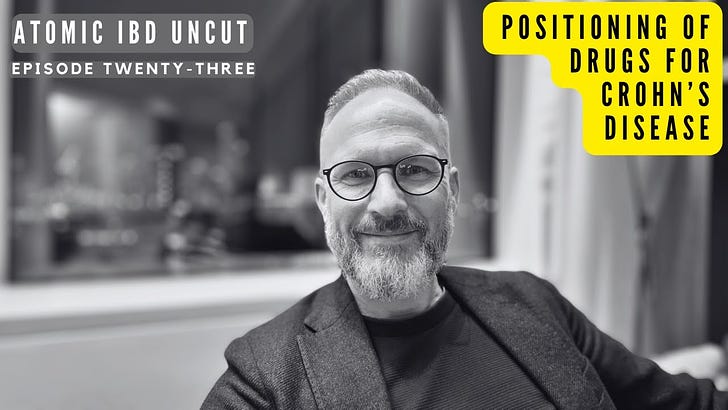A few key thoughts on positioning of drugs in Crohn’s disease
1. Start effective therapy early
This means at diagnosis in the vast majority of patients.
Don’t make patients earn their way onto an effective drug.
And use your best drug first. Please do not “save it in case you need it later”.
2. Which of our effective therapies should you start?
This matters less that just starting.
Think holistically with a patient-centered approach. Age, co-morbidities, extra-intestinal manifestations, pregnancy, etc all important.
Consider efficacy - speed of onset, mucosal healing, durability of remission - and safety.
Mode of delivery - intravenous, subcutaneous, oral - is important. But comes after patient factors, efficacy and safety.
Access issues will predominate for many. Use what you have. Use what you know.
Just use an effective drug.
3. Use a treat-to-target approach
Without labouring the points around STRIDE-2, I’ll put it very simply:
- monitor, monitor, monitor act on the results of the monitoring.
Don’t keep going with a therapy that isn’t working.
4. Know when to dose optimise versus switch
Optimising anti-TNF is often a good ploy.
But do it properly and don’t wait too long. Double the dose, shorten the frequency and wait 2-3 cycles. If it isn’t working then (objectively), switch out of class.
With ustekinumab, I would no longer dose optimise, but rather switch a partial responder to risankizumab.
5. Active disease is more dangerous than any drugs
Two bits of data this year show this:
In Profile, patients in the step-up group had twice as many adverse events as those in the top-down group. Most of this was because of flaring Crohn’s disease - including hospitalisations for severe disease - but there were also fewer serious infections in the top down group. And that was with combination infliximab and azathioprine.
Two meta-analyses of the harms from placebo in RCT’s show a very clear signal. Active Crohn’s disease and UC, when left untreated for even a number of week, is associated with increased toxicity.
6. Avoid steroids
The majority of patients with Crohn’s disease can be managed effectively now without steroids.
They will still have a role in sick patients, to bridge to some therapies, and a course of budesonide in mild to moderate ileal Crohn’s disease is often useful.
However we have better strategies now, including using JAK inhibitors in place of steroids. We are increasingly using a short course to (re)capture response to a biologic or keeping the JAKi going in combination at a low dose.
7. Other treatment modalities
Surgery and nutritional therapy are particularly important.
8. Changing the natural history of Crohn’s disease
Disease modification is the end result when following these principles.
We see it in the Edinburgh IBD clinic. A decade since we switched to a top-down strategy for Crohn’s disease and our patients have better disease control, less surgery and fewer hospitalisations.
Clearly we still have work to do, but this is major progress.



Can you expand on the nutrition aspect? My 9 years old son was diagnosed a year ago. On infliximab, trying 2 weekly doses as still high inflammation but no nutritional advice apart from "eat a well balanced diet". We are in Inverness.
Would it be possible to get a similar update for UC?